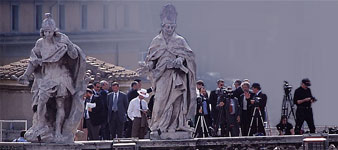I will address how the Catholic Church can better communicate news, information, and beliefs to web media. I will offer suggestions on the cooperation of experts; that is, the things web media outlets want to know when they call Church leaders and activists, as well as Catholic experts in matters like bioethics, and church-state separation.
When websites contact Catholic communications personnel, what sort of experts do they require? My paper will emphasize that websites need short, accurate, quick information about Church teaching, not long theological statements or complicated scholarly explanations. Experts on Church teaching should be able to clearly state the Church's position in simple sentences. An exercise that would be helpful for experts would be to create an FAQ (Frequently Asked Questions) about their subject. For example, an expert on Catholic teaching about fertility drugs could learn to shorten and clarify his thought by creating a list of five common questions and their answers.
Experts should also use terms that are understandable to all people. For example, if they are talking about euthanasia, they should avoid using the Catholic terms "extraordinary means" and "ordinary means," unless they can quickly and easily explain the difference. I will discuss how experts can offer reporters certain websites to link to in order to explain complicated Church terms, and suggest that Catholic communications personnel have a list of useful explanatory websites on hand.
In the past, Catholic communications personnel and Catholic experts knew who their audience was. If a secular newspaper called them, they knew how to frame their responses. If a diocesan newspaper called them, they also knew how to speak to that newspaper's readers.
On the web, it is not always possible to know who your audience is. Non-Catholics may use a search engine and find a statement given to a diocesan newspaper. Because of this, Catholic communications personnel must be careful to envision all the possible readers of the information, and be very clear. They must also be aware that if inaccurate information is released on the web, it is very difficult to correct; it spreads to many unlikely places over the internet. An example of this was a recent erroneous news article from Scotland about the Vatican's stance on Judas.
As part of this talk, I will describe what Beliefnet.com is (a multifaith web magazine) and give examples of how Beliefnet uses information provided by Catholic experts. I will also address the preconceptions and suspicions American audiences have about the Catholic Church, and how to dispel them. I will describe how Beliefnet uses charts, FAQs, audio, video, and photo galleries to explain religious concepts. I will explore how Catholic issues are discussed on internet message boards, and mention the voluntary presence of Catholic priests on certain websites where they answer user questions. Finally, I will address the growing phenomenon of weblogs, and how misinformation can be spread quickly via such blogs.



